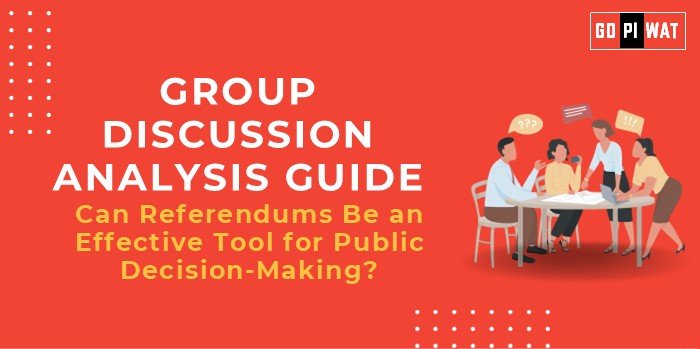📋 Group Discussion Analysis Guide: Can Referendums Be an Effective Tool for Public Decision-Making?
🌐 Introduction to Referendums
- 📖 Opening Context: Referendums provide a direct platform for citizens to make decisions on critical national or regional issues, bridging the gap between representative democracy and direct public participation.
- 💡 Topic Background: Historically, referendums have played a pivotal role in shaping policies, such as Brexit in the UK and constitutional amendments worldwide. They offer a unique mechanism for involving citizens in governance but also come with challenges like misinformation and oversimplification of complex issues.
📊 Quick Facts and Key Statistics
- 🌍 Global Usage: Over 150 national referendums have been held globally since 2000, reflecting their growing popularity in democracies.
- 📈 Voter Turnout: Average turnout in referendums is 70%, often higher than general elections, showcasing public interest.
- 🇬🇧 Case Study – Brexit: The 2016 UK referendum on EU membership had a 72.2% turnout, with 51.9% voting to leave.
- ⚖️ Complexity in Outcomes: 30% of referendums result in legislative conflicts due to ambiguous mandates.
- 💬 Digital Influence: In 65% of modern referendums, social media significantly shaped voter opinions, sometimes spreading misinformation.
👥 Stakeholders and Their Roles
- 🏛️ Governments: Set up frameworks and ensure transparency in conducting referendums.
- 🙋 Electorates: Make informed decisions on policies impacting their future.
- 📡 Media Outlets: Provide balanced information to guide public opinion.
- 🌐 Civil Society Groups: Advocate for or against referendum topics, ensuring diverse perspectives.
- 🔍 International Observers: Ensure fairness and adherence to democratic norms.
🏆 Achievements and Challenges
✨ Achievements:
- 🤝 Empowerment of Citizens: Referendums encourage active public participation, as seen in Switzerland, which conducts 4-6 referendums yearly on key issues.
- 📜 Policy Legitimacy: Publicly endorsed policies have greater acceptance and reduced resistance.
- 🌍 Global Recognition: Referendums in South Sudan (2011) led to its peaceful transition to independence.
⚠️ Challenges:
- ❌ Misinformation: The Brexit campaign saw widespread misinformation, complicating voter understanding.
- 📣 Polarization: Referendums often deepen societal divides, as seen in Catalonia’s independence vote (2017).
- ⚖️ Oversimplification: Complex issues, like EU membership, are often reduced to binary choices, ignoring nuances.
Global Comparisons:
- 🇨🇭 Switzerland: Frequent and successful referendums showcase inclusive governance.
- 🇺🇸 U.S.: Larger, diverse nations face challenges in adopting referendum models due to scale and complexity.
📚 Case Study: The European Union’s consultation platforms demonstrate how referendums can shape policy, exemplified by the Green Deal framework influenced by public input.
📄 Structured Arguments for Discussion
- 👍 Supporting Stance: “Referendums empower citizens, ensuring their voices are directly reflected in policy decisions.”
- 👎 Opposing Stance: “Referendums oversimplify complex issues and are vulnerable to misinformation, leading to flawed outcomes.”
- ⚖️ Balanced Perspective: “While referendums enhance public engagement, their effectiveness depends on clear framing, robust information dissemination, and transparency.”
💬 Effective Discussion Approaches
- 🎯 Opening Approaches:
- 📊 Use impactful examples: “The Brexit referendum reshaped Europe’s political and economic landscape, demonstrating the power of direct public decision-making.”
- 📈 Highlight statistical insights: “70% voter turnout in referendums often surpasses general election participation, reflecting public enthusiasm.”
- 🤝 Counter-Argument Handling:
- ✅ Acknowledge oversimplification and misinformation risks.
- 💡 Propose solutions like independent oversight and robust public education campaigns.
- 📜 Reference success stories like Switzerland’s referendum model.
🔎 Strategic Analysis of Strengths and Weaknesses
- 💪 Strengths: Enhances democratic participation, legitimizes policies, reflects public sentiment.
- ❌ Weaknesses: Risks of populism, polarization, oversimplified choices.
- 🌟 Opportunities: Educate voters, build consensus, innovate digital voting platforms.
- ⚠️ Threats: Manipulation by vested interests, low awareness among the electorate.
🎓 Connecting with B-School Applications
- 🌍 Real-World Applications: Understand referendums’ role in decision-making, corporate crisis resolution (e.g., employee referendums).
- 📝 Sample Interview Questions:
- 💡 “How can technology improve the integrity of referendums?”
- 🔍 “What lessons can businesses learn from referendum decision-making?”
- ✨ Insights for Students:
- 📖 Analyze decision-making mechanisms, stakeholder involvement, and outcomes for projects in governance and public policy.


